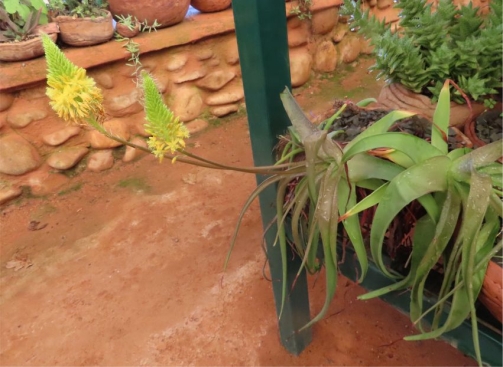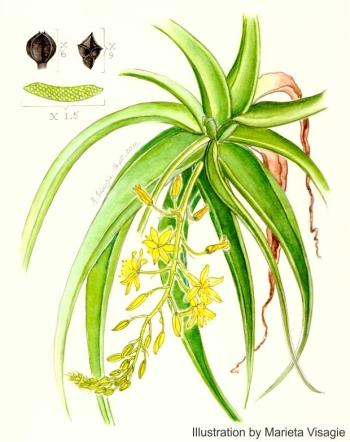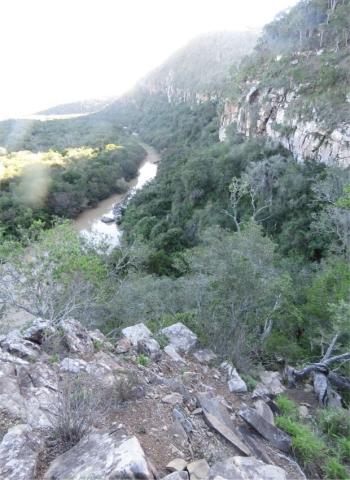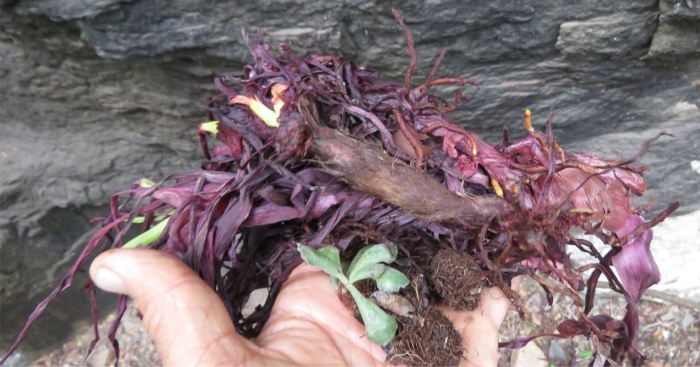Bulbine keiskammaensis
Bulbine keiskammaensis Van Jaarsv., Harrower & Hankey
Family: Asphodelaceae
Common names: Keiskamma bulbine (Eng.); Keiskamma kopieva (Afr.)
Introduction
Bulbine keiskammaensis is an aloe-like plant that hangs from the cliffs of the Keiskamma River in the Eastern Cape. It has drooping, sparingly branched stems, rosettes of soft leaves, and a solitary inflorescence bearing yellow flowers in spring. Best grown in containers and hanging baskets.

Fig. 1. Bulbine keiskammaensis flowering in the succulent house at Babylonstoren Farm.
Description
Description
The plants at first are solitary, with drooping rosettes of succulent leaves, dividing and forming decumbent to pendent clusters. The stems are 15–20 mm in diameter and up to 250 mm long with persistent purplish remains of leaves and leaf bases. The rosettes grow up to 600 mm diameter. The roots are grey-brown, fleshy, terete, ± 1.5–2.0 mm diam. The leaves 10–15 per rosette, initially ascending to ascending-spreading, linear-lanceolate, 200–450 ´ 12–30 mm, the tips drawn to a point (apex acuminate) and bearing a short stiff end (mucronate). The leaves are shallowly to deeply channelled (canaliculate) on the upper surface but rounded below, green and soft, also with faint lines (striate), the margin is entire. The inflorescence is 250–450 mm long and densely flowered in the upper third. The raceme up to 170–200 mm long; peduncle up to 2.5 mm diameter at base, biconvex. The floral bracts are linear, about 10–12 mm long, conspicuous in the young inflorescence and protruding far above the young flowers. The floral pedicles are12–15 mm long. The flowers (perianth) 18–20 mm in diameter when open, the tepals yellow with greenish yellow median stripes and sharp tips. The outer tepals narrowly spear-shaped (lanceolate), about 12 ´ 2.5 mm, the inner spear-shaped (lanceolate), 10 ´ 3 mm. The stamens (male parts) up to 7 mm long, bearded in central part, with hairs 1–1.5 mm long. The ovary (female part) rounded and about 2 mm in diameter. The style erect and about 4.8 mm long. The fruiting capsule is rounded (globose) and about 3.5 mm in diameter. The seed 2 ´ 1.5 mm, angular, greyish-black. Flowering is mainly in spring (September to November).

Fig. 2. Illustration of Bulbine keiskammaensis by Marieta Visagie.
Conservation Status
Status
The plant is locally common on cliffs along the Keiskamma River and well protected by its difficult to reach habitat. Consequently it can be regarded as not threatened.

Fig.3. The sheer cliffs of the Keiskamma River, habitat of Bulbine keiskammaensis.
Distribution and habitat
Distribution description
Only known from the lower Keiskamma River in the Eastern Cape. The vegetation consists of Buffalo Thicket (Albany Thicket Biome) (Mucina et al. 2006). The plants grow on sheer, shady to sunny, shale cliffs (Beaufort Shale, Adelaide subgroup), the rosettes drooping from the cliffs. Bulbine keiskammaensis shares its cliff face habitat with other succulent and bulbous plants such as Portulacaria afra, Fockea edulis, Delosperma tradescantioides and D. stenandrum, Ceropegia stapeliiformis, Crassula multicava, C. nemorosa, C. orbicularis, C. lactea, C. intermedia, C. spathulata and C. cordata, Haemanthus albiflos, Dracaena aletriformis, Senecio voigtii, S. angulatus and S. macroglossus, Curio talinoides, Cyphostemma cirrhozum, Peperomia blanda, Pelargonium inquinans, Tetradenia barberae and Agapanthus praecox.
The shale substrate has many fissures, ledges and crevices, ideal for establishment of plants. The temperature during summer is high (35°C). The winters are cooler and frost is absent. Most of the rainfall occurs in the summer, in the form of thunder showers, but some rain may fall during winter, due to cold fronts, and averages between 400–700 mm per annum. Plants grow at an altitude of about 400–600 m.

Fig. 4. Bulbine keiskammaensis growing in its native habitat along the Keiskamma River (Eastern Cape). Note the spreading pendent leaves.
Derivation of name and historical aspects
History
Bulbine keiskammaensis was collected by the author and two colleagues, Adam Harrower and Andrew Hankey, along the Keiskamma River on 24 April 2019. It was during a rubber canoe expedition, exploring the cliffs and semi-coastal parts of the Keiskamma River in the Eastern Cape as part of the author’s annual riverine expeditions. The plant was named by us in Bradleya, the yearbook of the British Cactus and Succulent Society, in 2020. The Keiskamma River is situated between Gqeberha and East London (Eastern Cape, South Africa). The name Keiskamma, according to Nienaber & Raper (1983) is Khoekhoen in origin, and means “place of the puff adders (Bitis arietans)”. When the plant came into flower at Babylonstoren Farm, it was illustrated by the botanical artist Marieta Visagie in 2020.

Fig. 5. The persistent fibrous remains of the leaves of Bulbine keiskammaensis.
Bulbine keiskammaensis differs from other cliff-dwelling bulbines by its pendent stems and pendent, soft, linear-lanceolate, green, deeply channelled, succulent leaves up to 450 mm long. The plants divide and proliferate from the base, forming small, dense clusters, which become pendent. It is related to B. latifolia and B. natalensis (solitary plants with shorter sems) which are widespread in the Eastern Cape.
Characteristics of Bulbine keiskammaensis that distinguish it are the purplish fibrous networks of persistent remains of leaf bases (Fig. 4), and the numerous linear floral bracts (10-12 mm long) in the young raceme that protrude far above the flowers buds.

Fig. 6. A young raceme of Bulbine keiskammaensis, note the distinctly long floral bracts protruding above the flower buds.
Ecology
Ecology
Plants grow in a relatively safe cliff-face environment from which larger herbivores are absent and also protected from fires. The flowers are pollinated by insects and the fruiting capsule ripens during summer, the seed dispersed by wind. The drooping nature of the stems and leaves is an adaptation to its cliff-face habitat. The succulent nature of the plant (leaves, stems, roots) enables the plant to cope during the dry winter season.

Fig 7. Flowers of Bulbine keiskammaensis, succulent house, Babylonstoren Farm.
Uses
Use
No medicinal or cultural uses have been recorded.
Growing Bulbine keiskammaensis
Grow
Bulbine keiskammaensis can be grown with relative ease from seed or cuttings and is not shy to flower. It can also be grown in containers as well as hanging baskets and in vertical gardens. We have grown them successfully in soil consisting of 2 parts sand, 1 part compost and 1 part garden loam. At Babylonstoren Farm we planted them in handmade containers (artist Ronnie van der Walt) . Plants grow relatively fast. Best for a shady and filtered sunlight position. The plant responds to an organic fertiliser. In the garden plant on a shady embankment which allows the plant to become pendent. As a pot plant, it is best on a balcony or windowsill where the plant can become pendent. During the summer months (growing season) the plant should be regularly watered.

Fig. 8. Inflorescence of Bulbine keiskammaensis, succulent house at Babylonstoren Farm.
Plants can be divided in late winter and replanted in a shallow tray in a sandy mixture (peat, sand and polystyrene) and kept moist. Rooting is within 3 weeks and once well rooted transfer to individual containers. Place container in a shady position but with full light. The south side of a building is ideal.
Sow seed in spring or summer in a sandy medium. First moisten the substrate with fine rose. Sow the seed and cover lightly with a thin layer of sand. Keep moist and in a shady area. Germination is usually within 3 weeks and the young seedlings are slow growing. Transplant seedlings to individual containers once large enough to handle.
When plants are over watered fungi can cause problems
References
- Mucina, L. & Rutherford, M.C. (eds) 2006. The vegetation of South Africa, Lesotho and Swaziland. Strelitzia 19. South African National Biodiversity Institute, Pretoria.
- Nienaber, G.S. & Raper, P.E. 1983. Hottentot (Khoekhoen) place names. Butterworth Publishers, Durban.
- Van Jaarsveld, E.J. & Forster, P.I. 2019. Bulbine. In U. Eggli & Nyffeler (Editors) Illustrated handbook of Succulent Plants, Volume 1: 713-738. Monocotyledons (Agavaceae to Asphodelaceae), Second Edition. Springer, Germany.
- Van Jaarsveld, E.J., Harrower, A., & Hankey, A. 2020. Bulbine keiskammaensis, a new cliff-dwelling Bulbine species (Asphodelaceae) from the Eastern Cape. Bradleya 38: 268–272.
Credits
Ernst van Jaarsveld
Kirstenbosch National Botanical Garden (Retired 2015)
Babylonstoren Farm
Extraordinary senior lecturer and researcher,
Department of Biodiversity and Conservation, University of the Western Cape
December 2022
Acknowledgements: the author thanks Babylonstoren Farm and the owner Mr Koos Bekker for their continual support.
Plant Attributes:
Plant Type: Shrub
SA Distribution: Eastern Cape
Soil type: Sandy, Loam
Flowering season: Spring, Early Summer
PH: Acid, Neutral
Flower colour: Yellow
Aspect: Morning Sun (Semi Shade), Afternoon Sun (Semi Shade)
Gardening skill: Average
Special Features:
Horticultural zones








Rate this article
Article well written and informative
Rate this plant
Is this an interesting plant?
Login to add your Comment
Back to topNot registered yet? Click here to register.